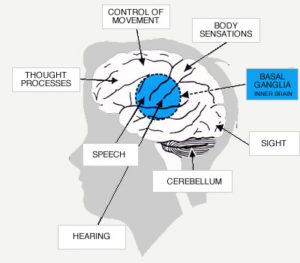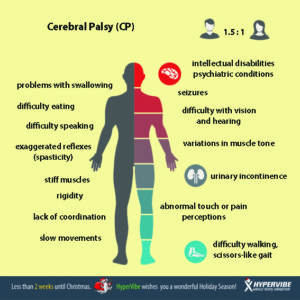
Cerebral Palsy is a damage to a part of the brain and depending where the damage is will tell what symptoms to expect but for starters lets understand what is affected by this disease.
UNDERSTANDING HOW CEREBRAL PALSY AFFECTS THE HUMAN BODY:
You have parts to the brain dividing it in a simplistic term, right now, take 2 sections:
1=Cerebrum is for thinking, muscular functioning both in our control (ex.muscle movement of our extremities) and not in our control (ex. the indicating of neuro=stimulation to tell the brain it’s time to urinate through neuro impulses from the bladder to the brain who tells us get up and go to the bathroom but through out muscle control we hold it till we get to the toilet).
2= Cerebellum for is for balance. Cerebellar damage produces disorders in fine movement, equilibrium, posture, and motor learning in humans.
Cerebrum vs Cerebral Cortex
The nervous system is important to control and coordinate all the actions of an organism and transmit signals between different parts of the body. The system is basically made up of specialized cells called neurons. The complexity of the nervous system increases with the complexity of the body of organisms. Most primitive animals like sponges, flatworms have a very simple nervous system while advanced animals like vertebrates have a highly complex nervous system with larger brains. Brain is one of the largest and most amazing organs in an organism that can be categorized under the central nervous system. The human brain can be divided into three categories, namely, forebrain, midbrain and hindbrain. Both the cerebrum and cerebral cortex come under the forebrain.
Cerebrum
Cerebrum is the largest and most prominent part of the human brain. It appears to envelop the rest of the brain as it constitutes 4/5 of its weight. It is split longitudinally into two large, prominent hemispheres; left and right by deep median fissure called ‘cerebral fissure’. These two hemispheres are connected through a horizontal sheet of nerve fibers known as corpus callosum. Each hemisphere is further divided into the frontal, parietal, temporal, and occipital lobes by three deep fissures, namely, central, parieto-occipital and sylvian fissure. Each hemisphere receives sensory input from the contra lateral side of the body and exerts motor control over that side. The basic function of the cerebrum is to control voluntary functions and seat of intelligence, will power, memory, reasoning, thinking, learning, emotions, speech etc. The cerebrum is made up of 5 regions. It deals with our sensory and motor and thinking function.
Cerebral Cortex
The layer of gray matter, about 2 to 4 mm thickness, on the outer surface of the cerebrum is called the cerebral cortex. In humans, the cerebral cortex is densely packed with over 10 billion nerve cells (about 10% of all the neurons in the brain) and, therefore, much of the neural activities of the cerebrum take place within this layer.
The outer surface of the cerebral cortex is highly convoluted (twisted or coiled and involved), and this convoluted surface increases the surface area of the cerebral cortex. The ridges of these convolutions are called ‘gyri’ and depressions between them as ‘sulci’. Each region is responsible for a particular function. According to the function or activity, the regions of the cerebral cortex can be divided into three general categories motor, sensory, and associative (they work together).
The motor cortex is generally associated with the movement of body parts and sensory cortex such as auditory cortex, visual cortex etc. is associated with sensory organs. There is a portion of the cerebral cortex which is not occupied by motor and sensory cortices, known as the ‘association cortex’. This region is devoted for higher mental activities, so that in higher primates, especially in humans, it covers 95% of the total cerebral cortex surface.
What is the difference between Cerebrum and Cerebral Cortex?
- Cerebral cortex is a part of the cerebrum. Cortex means the outer region of an organ.
- Cerebrum is the largest and most prominent part of the brain (it makes up 4/5 of the brain). Cerebral Cortex is the outer layer of the cerebrum.
- Cerebrum has both gray and white matter while the gray part of it is considered the cerebral cortex.
- Human cerebral cortex is made up of approximately 10 billion nerve cell bodies and their dendrites=the branching process of a neuron that conducts impulses toward the cell to allow a function to take place that the cerebral cortex does; whereas the cerebrum has both cell bodies and nerve fibers.
The part affected in Cerebral Palsy is the Cerebral Cortex.
Cerebral palsy (CP) refers to a group of neurological disorders that appear in infancy or early childhood and permanently affect body movement and muscle coordination Cerebral palsy (CP) is caused by damage to or abnormalities inside the developing brain that disrupt the brain’s ability to control movement and maintain posture and balance. The term cerebral refers to a part of the brain=cerebrum; palsy refers to the loss or impairment of motor function (in varying intensities). Remember each pt diagnosed with this is unique with problems and intensities but maybe similar to some who have it also.
Cerebral palsy affects the motor area of the brain’s outer layer (called the cerebral cortex), the part of the brain that directs muscle movement.
In some cases, the cerebral motor cortex hasn’t developed normally during fetal growth. In others, the damage is a result of injury to the brain either before, during, or after birth. In either case, the damage is not repairable and the disabilities that result are permanent.
Cerebral Palsy is a condition in which there may be abnormal brain development or injury to the brain as it develops. This can occur before, during, after birth or during early childhood.
It is the brain’s control over various sensory, muscle or co-ordination functions that is affected. So, although there is no injury to the hands or legs themselves, a child with Cerebral Palsy may not be able to walk or move his or her hands in a co-ordinated purposeful way.
Depending on which part of the brain is affected, the Cerebral Palsied person may not be able to talk, see, hear or understand normal thought processes.
Children with Cerebral Palsy have difficulties in controlling muscles and movements as they grow and develop. The nature and extent of these difficulties may change as children grow but Cerebral Palsy itself is not progressive: the injury or impairment in the brain does not change. However, the effects of the brain injury on the body may change over time for better or worse.
Physiotherapy and other therapies can often help people with Cerebral Palsy reach their full potential and become more independent. Therefore, children with Cerebral Palsy will often be referred to a therapist or see a multi-disciplinary team. Depending on the precise area of the brain that is affected, there may be associated difficulties which become obvious during development; for example, in vision, hearing, learning and behaviour.
THERE ARE NO 2 CASES THAT ARE THE SAME!

